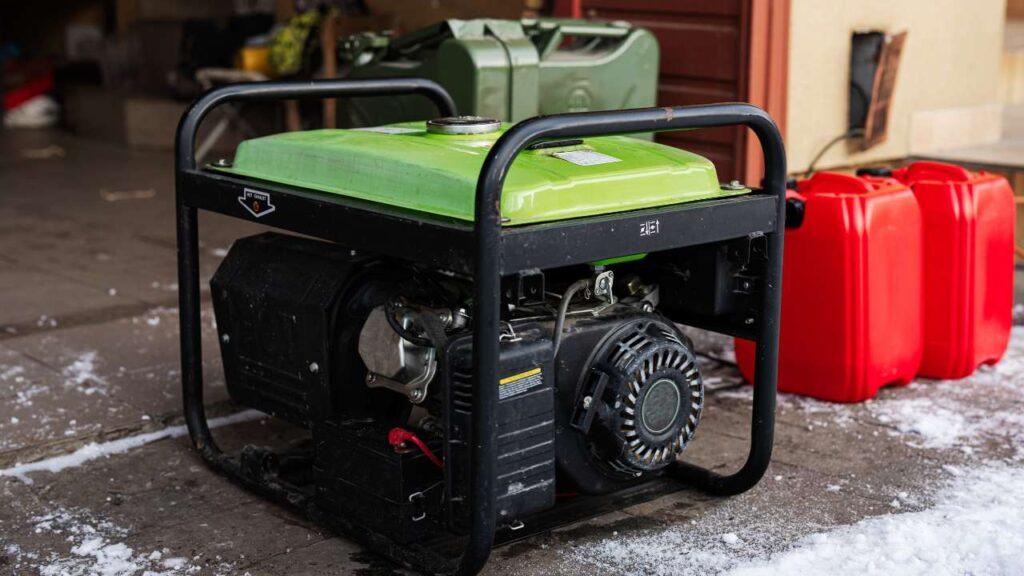Generator covers are tailored shields designed to protect generators from harsh weather, dust, and damage, ensuring long-lasting performance. In this guide, we have extensively researched, reviewed, and ranked the 7 best generator covers in 2025.
We’re reader-supported. When you buy through links on our site, we may earn an affiliate commission. As an Amazon Associate, we earn from qualifying purchases.
Our Top 7 Picks of The Best Generator Covers
1. Best Overall Option: Porch Shield Waterproof Universal Generator Cover
2. Best Budget Option: Westinghouse Outdoor Power Equipment WGen Generator Cover
3. Value Option: WLEAFJ Generator Cover
4. Heavy-Duty Option: IGAN Generator Tent Running Cover
5. Tent Shape Option: GenTent Generator Running Cover
6. Enclosed Option: GENSHED Generator Shed
7. Compact Option: Zettum Generator Cover
What Is The Best Generator Cover In 2025?
Choosing the best generator cover in 2025 isn’t just about looks. It’s about finding one that offers durability, protection, and reliability. Furthermore, the right cover ensures your generator stays functional for years. Here is a list of top-rated generator covers that meet all these needs:
1. Best Overall Option: Porch Shield Waterproof Universal Generator Cover
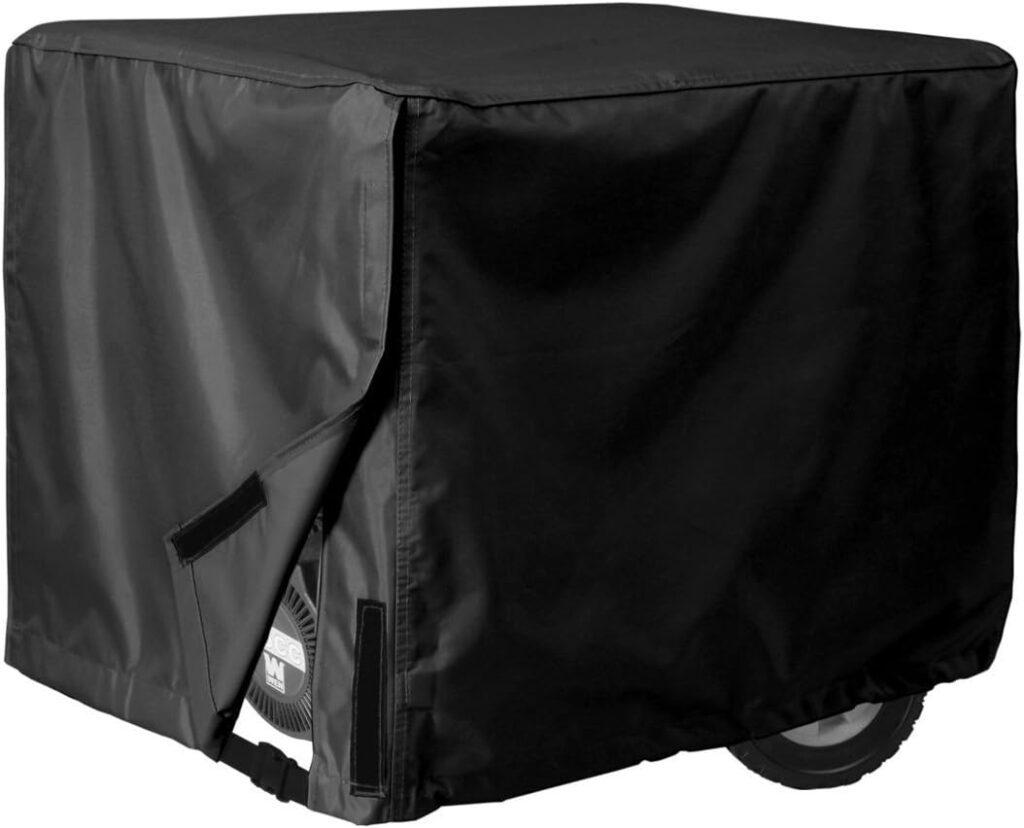
Key Specifications
- Brand: Porch Shield
- Dimensions: 32 x 24 x 24 inches
- Material: 600D Polyester with Waterproof Backcoating
- Item Weight: 1.1 Pounds
- Water Resistance Level: Waterproof
If you’re looking for a solid generator cover that actually does its job, this one from Porch Shield is worth considering. It’s made from thick 600D polyester, which feels tough and reliable. From our perspective, it holds up well against rain, snow, and even dust. It’s not one of those flimsy covers that barely last a season. This one is built for long-term use.
Another thing we like is the way it fits. It’s got an elastic hem and bottom strap, which keeps it snug even in strong winds. No one wants to find their cover blown halfway across the yard. Plus, the Velcro side makes it easy to take off and put back on without struggling. The extra ventilation built into the design is also a nice touch, helping prevent moisture buildup inside.
Pros
- Heavy-duty fabric that stands up to rough weather
- Stays in place with an elastic hem and bottom strap
- Vents allow airflow to reduce moisture buildup
- Comes in multiple sizes to fit different generators
Cons
- Not meant for use while the generator is running
- The black color absorbs heat, which might not be ideal in extreme heat
From our standpoint, this is a proper pick for anyone who wants to keep their generator safe when it’s not in use. It’s got the right balance of durability, secure fit, and ease of use. It’s not overcomplicated, just a solid, reliable cover that does what it’s supposed to. If you want something that’ll hold up and actually protect your generator, this one checks all the right boxes.
2. Best Budget Option: Westinghouse Outdoor Power Equipment WGen Generator Cover

Key Specifications
- Brand: Westinghouse
- Dimensions: 28.5 x 24.5 x 25 inches
- Material: Polyester
- Item Weight: 0.25 Pounds
- Water Resistance Level: Water-Resistant
If you’re looking for a budget-friendly way to keep your generator protected, this cover from Westinghouse is worth considering. From our perspective, it’s a straightforward, no-fuss option that does what it needs to. It’s made from durable polyester with high-density stitching, which gives it a decent level of protection against dust, dirt, and UV rays. It’s not the thickest cover out there, but for everyday storage, it gets the job done.
One thing we appreciate is the universal fit and drawstring closure, which makes it easy to secure around different generator sizes. It’s lightweight and simple to put on or remove, which is a plus if you’re using your generator frequently. From our standpoint, this is a solid choice for anyone who needs a protective cover without spending too much.
Pros
- Lightweight and easy to handle
- Universal fit works with multiple generator models
- Drawstring closure ensures a snug and secure fit
- Provides decent protection against dust, dirt, and UV exposure
Cons
- Not fully waterproof, more suited for covered outdoor areas
- Material is thinner compared to premium options
From our standpoint, this cover is the proper pick for those who want reliable generator protection without spending a lot. It covers the basics well—keeping dirt, dust, and sunlight off your generator while offering a secure fit. While it may not be the thickest or most heavy-duty option, it serves its purpose for everyday storage. If you’re after an affordable and effective generator cover, this one checks all the right boxes.
3. Value Option: WLEAFJ Generator Cover
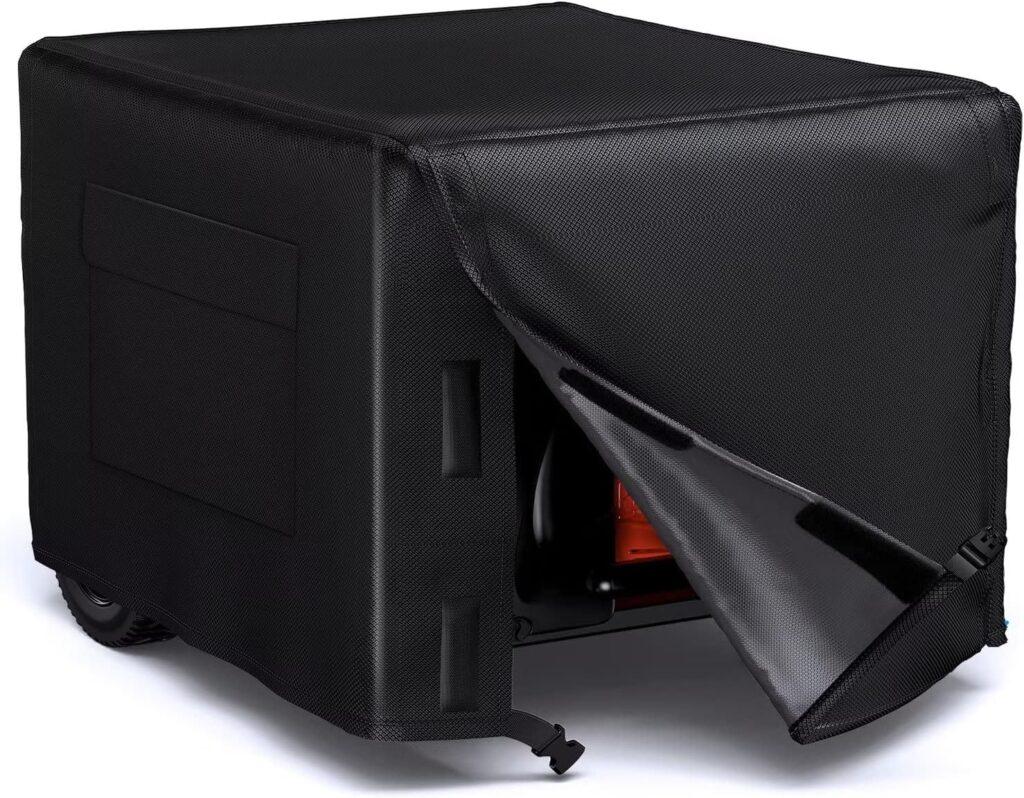
Key Specifications
- Brand: WLEAFJ
- Dimensions: 32”L x 24”W x 24”H
- Material: Oxford fabric
- Item Weight: 0.4 Kilograms
- Water Resistance Level: Waterproof
If you’re looking for a solid generator cover that doesn’t cost a fortune, this one from WLEAFJ seems like a good pick. It’s made of heavy-duty oxford fabric, so it feels durable enough to handle rain, dust, and general wear and tear. From our perspective, the waterproof coating does a decent job of keeping moisture out, which is always a plus if your generator is stored outside. It also has a drawstring and buckle straps that help secure the cover in place, especially in windy conditions.
One thing we like is the storage pocket on the side. It’s a nice little addition that makes it easy to keep small accessories like power cords and oil funnels in one place. The Velcro opening on the side also makes putting the cover on and taking it off way easier. We think it’s a well-thought-out design that balances protection with convenience, which isn’t always the case with budget-friendly covers.
Pros
- Heavy-duty fabric that holds up well against the elements
- Adjustable straps and drawstring help keep it secure in strong winds
- Velcro side opening makes it easy to put on and remove
- Handy storage pocket for small accessories
Cons
- Might be a bit oversized for smaller generators
- Black color may fade if left in direct sunlight for too long
From our standpoint, this cover is a proper choice if you’re looking for something durable, easy to use, and functional without spending too much. It’s not overly complicated, but it does what it’s supposed to do—protect your generator from the elements while being easy to manage. The added features like the storage pocket and secure fit make it feel like a good investment for anyone wanting a reliable generator cover that won’t break the bank.
4. Heavy-Duty Option: IGAN Generator Tent Running Cover
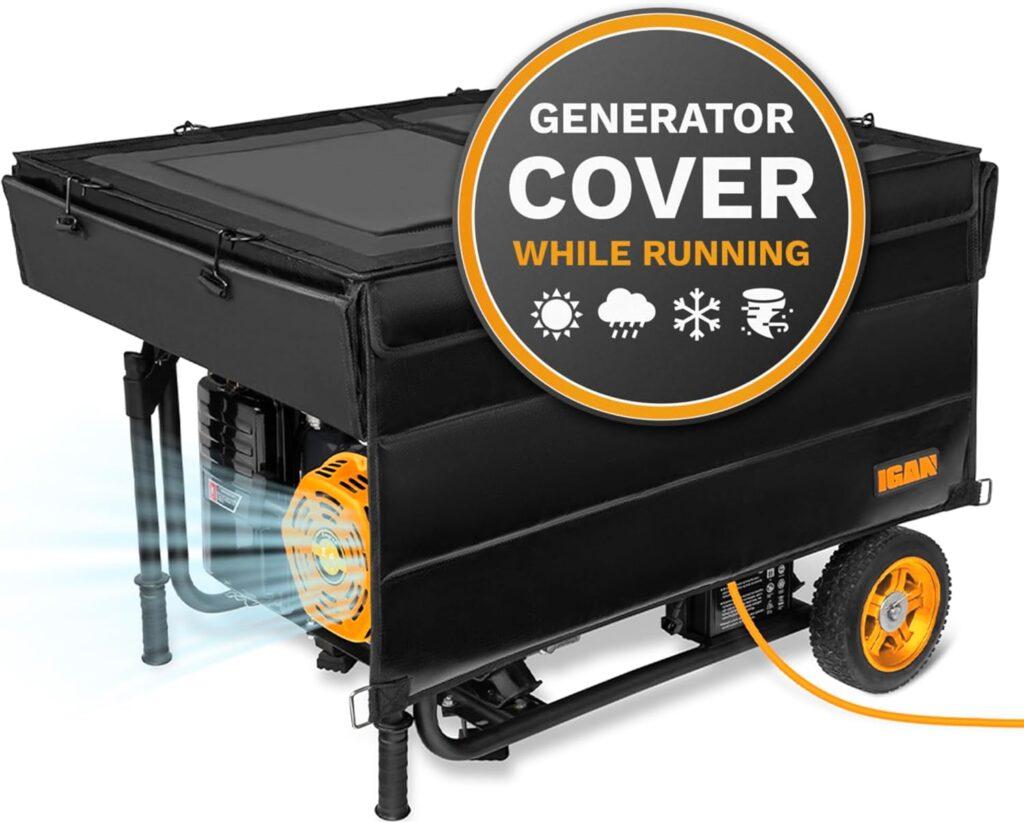
Key Specifications
- Brand: IGAN
- Dimensions: 33 x 25.5 x 18.5 inches
- Material: Tarpaulin with Stainless Steel Frame
- Item Weight: 9 Pounds
- Water Resistance Level: Waterproof
If you need a generator cover that can handle just about anything, this one from IGAN is worth considering. From our perspective, it’s built tough with a heavy-duty tarpaulin cover and a stainless steel frame, making it a solid option for those who want long-term protection. Unlike regular covers, this one works both as a storage cover and a running cover, meaning you can keep your generator protected even while it’s in use.
One thing we really like is its all-weather resistance. Whether it’s heavy rain, snow, or strong winds, this cover holds up well. The frame adds extra stability, which is something a lot of soft covers lack. From our standpoint, the easy assembly is another plus. It doesn’t take much effort to set it up, and it folds down compactly when not in use. It’s a well-thought-out design that provides solid protection while still being practical.
Pros
- Sturdy metal frame adds stability and long-term durability
- Works as both a running and storage cover
- Waterproof tarpaulin protects against harsh weather conditions
- Easy to assemble and folds down for storage
Cons
- Heavier than standard covers, so may take a little effort to move
- Takes up more storage space compared to simple fabric covers
From our perspective, this IGAN cover is a proper choice for those looking for serious protection. The heavy-duty frame, waterproof material, and dual-purpose design make it an excellent option for keeping a generator safe in any weather. It’s a bit more robust than traditional covers, but if you want something reliable and built to last, this one stands out.
5. Tent Shape Option: GenTent Generator Running Cover
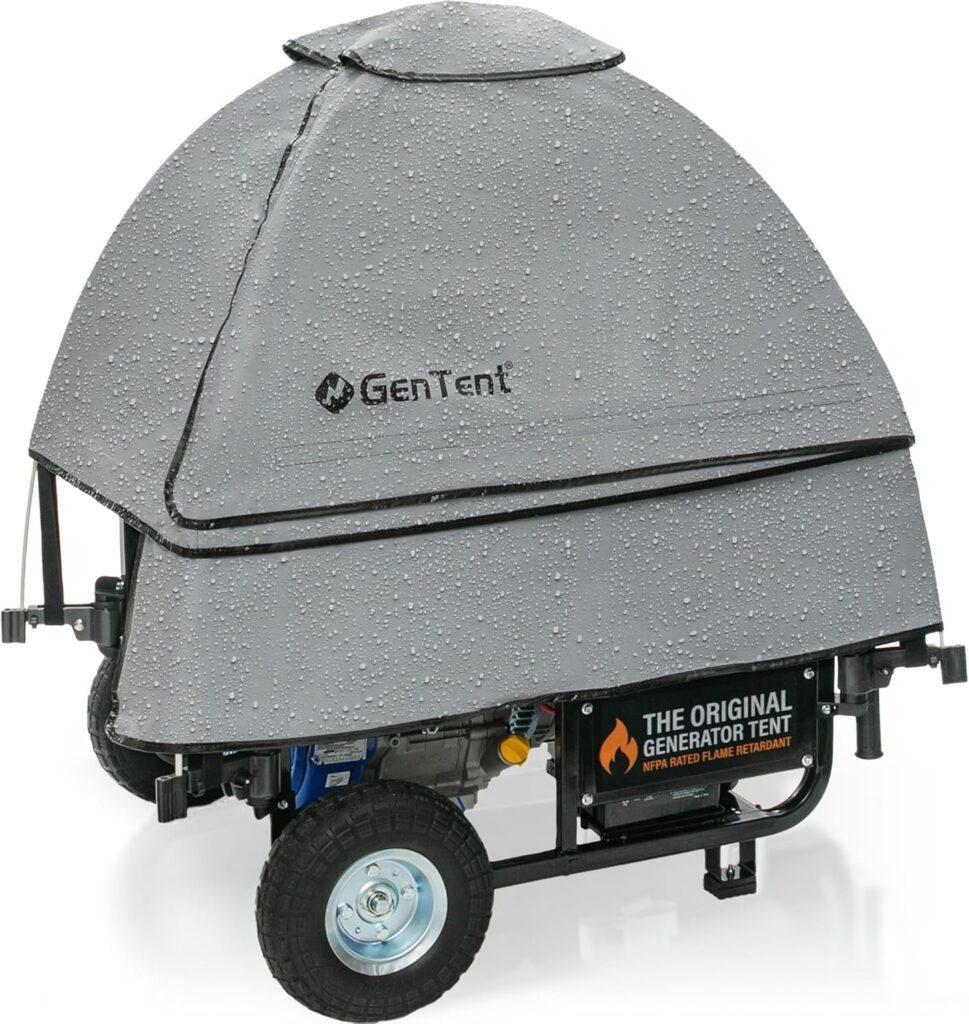
Key Specifications
- Brand: GenTent Safety Canopies
- Dimensions: Fits generator perimeters ranging from 76″-104″
- Material: Standard
- Item Weight: Not specified
- Water Resistance Level: Waterproof
If you’re looking for a tent-style generator cover that allows you to safely run your generator in any weather, this one from GenTent is a solid choice. From our perspective, it stands out because it doesn’t just protect your generator while it’s stored—it also works while the generator is running. That means rain, snow, or wind won’t be an issue when you need backup power. The cover is designed to keep water away from electrical components while still allowing proper ventilation.
Another thing we like is the universal fit and secure attachment system. It comes with clamps and adapters, making it easy to attach to most open-frame generators. From our standpoint, the large access door is another great feature, letting you refuel quickly without needing to remove the cover. It’s built for function, and we think it’s a smart option for anyone who needs their generator running no matter the weather.
Pros
- Works while the generator is running, providing protection in all weather
- Universal fit with adapters and clamps for easy installation
- Large access door makes refueling quick and hassle-free
- Doesn’t block airflow, allowing the generator to cool properly
Cons
- Setup takes a bit longer compared to standard covers
- Only designed for open-frame generators, limiting compatibility
From our standpoint, this GenTent cover is a proper option for those who need their generator running in tough weather. The tent-like design, waterproof protection, and ventilation-friendly setup make it an excellent choice for keeping your generator safe while in use. If you need a practical and weather-resistant solution, this one definitely delivers.
6. Enclosed Option: GENSHED Generator Shed
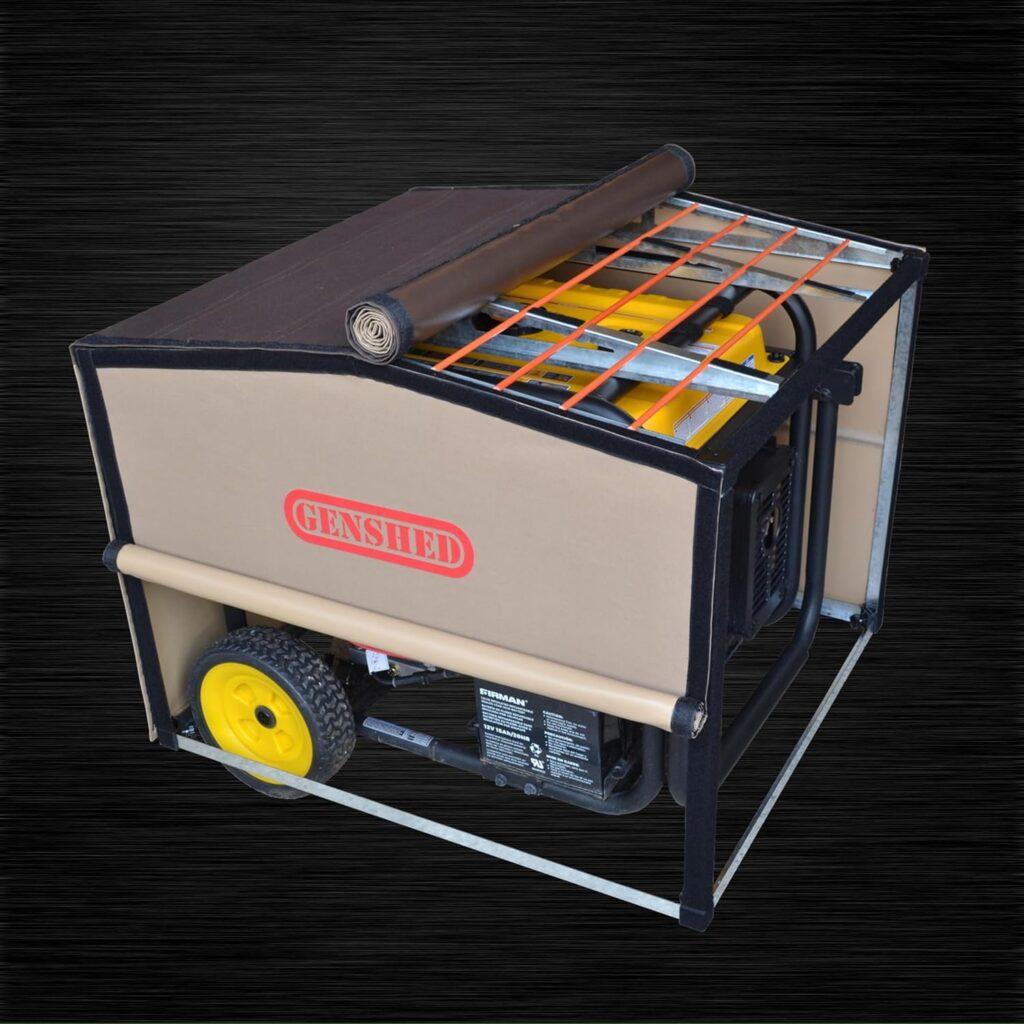
Key Specifications
- Brand: GENSHED
- Dimensions: 31.5″L x 27.5″W x 24″H
- Material: Steel
- Item Weight: Not specified
- Water Resistance Level: Not specified
If you’re looking for a generator cover that does more than just cover, this GENSHED shed is an interesting option. From our standpoint, it offers a smart combination of storage and running protection, meaning you don’t have to remove the cover when using your generator. The steel frame gives it a solid structure, and the fabric is positioned in a way that keeps it from touching the generator while it’s running. That’s something we don’t often see in standard covers.
One of the things we really like is the ease of use. The side panels open at different heights, allowing for ventilation and easy access. Plus, no tools are needed for setup, which is always a bonus. From our perspective, the ability to move the generator with the shed on is another handy feature. It saves time and effort, especially if you need to relocate it for camping, RV trips, or job sites.
Pros
- Functions as both a storage and running cover
- Sturdy steel frame adds durability and protection
- Side panels open for ventilation and easy generator access
- No tools needed for assembly or disassembly
Cons
- Takes up more space than traditional soft covers
- Heavier than fabric covers, making transport a bit less convenient
From our standpoint, this GENSHED shed is a proper choice for those who want a durable, all-in-one solution. The steel frame, versatile design, and easy access panels make it an excellent option for anyone needing long-term generator protection. It’s a practical upgrade over traditional covers, offering both security and convenience.
7. Compact Option: Zettum Generator Cover

Key Specifications
- Brand: Zettum
- Dimensions: 32″ x 24″ x 24″
- Material: 600D Oxford Cloth & PU Coating
- Item Weight: 0.64 Kilograms
- Water Resistance Level: Waterproof
If you’re looking for a simple, no-nonsense generator cover that actually holds up, this one from Zettum seems like a solid option. It’s made from thick 600D oxford cloth with a waterproof PU coating, so it doesn’t feel flimsy like some of the cheaper covers out there. From our standpoint, it does a good job protecting against rain, wind, and dust, making it a practical choice for keeping your generator in good shape.
One thing we like is how easy it is to put on and take off. Some covers can be a hassle, but this one fits well without too much struggle. The quick-release buckles and Velcro straps help keep it secure, which is especially handy in windy conditions. It also has UV-resistant coating, so it won’t fade too fast in the sun. From our perspective, it’s a great option for anyone needing a durable cover without overcomplicating things.
Pros
- Sturdy material that holds up well in different weather conditions
- Quick-release buckles and Velcro straps keep it from blowing away
- UV-resistant coating helps prevent fading from long sun exposure
- Easy to install and remove without much hassle
Cons
- Not meant to be used while the generator is running
- The black color might absorb heat if left in direct sun for too long
From our standpoint, this Zettum generator cover is a proper choice for anyone wanting a compact, reliable way to protect their generator. It’s well-built, easy to use, and does what it’s supposed to. Nothing fancy, just a solid cover that keeps your generator safe from the elements. If you need something dependable without spending a fortune, this one does the job.
How the Generator Covers Were Tested
To create a well-rounded list of the best generator covers, a combination of real-world testing, expert evaluation, and customer feedback was used. Each cover was tested under various conditions to ensure it met the highest standards for performance, durability, and usability. Online forums and review platforms were also explored to understand real customer experiences and identify the most common issues and benefits.
- Weather Resistance: Covers were exposed to rain, snow, and direct sunlight to assess their ability to withstand extreme weather. This included testing for waterproofing, UV resistance, and overall performance under prolonged exposure to harsh conditions.
- Material Quality: We checked the quality of fabrics, focusing on durability, thickness, and tear resistance. Materials like polyester, vinyl, and canvas were evaluated for their strength and longevity.
- Ease of Use: The covers were tested for convenience, such as how easy it was to put them on, remove them, and secure them properly. Features like zippers, straps, and buckles were evaluated for practicality.
- Fit and Coverage: Covers were fitted on generators of varying sizes to ensure proper coverage. A snug fit was prioritized, while oversized or poorly fitting covers were flagged as ineffective.
- Ventilation and Airflow: For vented covers, we checked airflow during generator operation to ensure they prevent overheating. Poorly ventilated covers were excluded from the list.
- Customer Feedback: Reviews and ratings on forums, online retailers, and user testimonials provided valuable insights into long-term performance and common issues. Covers with consistent positive feedback from real users ranked higher.
- Longevity: Covers were monitored over weeks to simulate extended use. Wear and tear, resistance to fading, and material degradation were key factors in determining durability.
Combining hands-on testing with insights from real users ensures a comprehensive evaluation of each cover. By considering both lab-like conditions and customer experiences, we can confidently recommend the most reliable generator covers for all types of needs and climates.
Why Do You Need a Generator Cover?
Alright, let’s be real for a second. A generator cover might not seem like the most exciting thing to buy, but it’s a lifesaver for your machine. It protects your generator from rain, snow, dirt, and even that annoying layer of dust that somehow always finds its way in. Without a cover, all these things can mess up your generator’s insides, leading to expensive repairs. Plus, if you’re like most people, you probably don’t want to spend hours cleaning it every time you need to use it. A cover keeps it ready to go and saves you from headaches down the line.
How Do Generator Covers Protect Your Investment?
Think of a generator cover as a shield – nothing fancy, but it gets the job done. It blocks out rain and snow, which means no rust or water damage. That’s already a big win because once rust sets in, it’s game over for some parts of your generator.
Covers also keep out dirt and debris, which can clog up vents or mess with the engine. No one wants to deal with a generator that sputters just because some leaves got stuck inside.
And here’s the best part – it’s low effort. Put the cover on, and your generator stays in good shape. No constant cleaning or worrying. It’s just a small step that saves you big bucks in repairs.
What Are the Risks of Not Using a Cover?
Skipping the cover? That’s a risk you might not want to take. Here’s what could happen:
- Rust and Corrosion: Rain and humidity can slowly eat away at metal parts.
- Engine Clogging: Dirt, dust, and debris can block the engine and reduce performance.
- Electrical Issues: Moisture can mess with wiring and circuits, causing failures.
- Shorter Lifespan: Generators wear out faster when left exposed to the elements.
Why go through all the trouble of repairs or replacements when a simple cover can avoid it all? Honestly, spending a little on a cover now saves a lot of hassle later.
How Can a Cover Improve Generator Longevity?
A cover is one of those small things that can make a huge difference. First off, it keeps moisture out, which means no rust or corrosion. If you’ve ever dealt with rust, you know how fast it can ruin metal parts.
It also keeps your generator clean by blocking out dirt and debris. When your vents and filters are clear, your generator runs smoother and doesn’t overwork itself. That’s less strain on the motor, and fewer breakdowns to worry about.
Some covers even have insulation for winter. This helps prevent freezing or overheating, so your generator is always ready to fire up when you need it. It’s just a smart way to keep your investment in great shape for years.
What Are the Different Types of Generator Covers?
There’s no one-size-fits-all when it comes to generator covers. Here are some of the common types:
- Waterproof Covers: Great for wet climates; keeps rain and snow out.
- Insulated Covers: Perfect for cold areas to prevent freezing.
- Heavy-Duty Covers: Made for rugged use with thick, durable materials.
- Vented Covers: Allows air to flow while running the generator.
- Universal Fit Covers: Adjustable and fits most standard generators.
- Custom Fit Covers: Designed specifically for your generator model.
Each type has its perks, so it really depends on your needs. Whether you’re dealing with heavy rain or just want a dust barrier, there’s a cover out there that’s right for your generator. Simple as that.
How to Buy The Best Generator Cover According To Your Generator
Finding the best generator cover isn’t rocket science, but it does take a little thought. From size to features, there are a few things to get right if you want maximum protection.
What Size Cover Do You Need?
Picking the right size cover is key because a poor fit won’t protect your generator properly. Here’s how you can figure out the perfect size:
- Measure Your Generator: Take note of its height, width, and depth.
- Check Manufacturer’s Specs: Some covers are made specifically for certain models.
- Go Slightly Bigger: If you’re unsure, choose a cover slightly larger for extra room.
- Avoid Oversized Covers: They can be loose and let water or dirt sneak in.
Having the right size means your generator stays snug and fully protected, leaving no room for errors. So, grab that measuring tape before you shop.
How to Match Your Cover to Your Climate
Your local weather plays a big role in deciding which cover you need. Different covers work better for different conditions.
- For Rainy Areas: Go for a waterproof cover with sealed seams.
- For Sunny Locations: Choose one with UV protection to prevent fading and cracking.
- For Snowy Winters: An insulated cover is your best bet to keep the generator warm.
- For Windy Regions: Look for covers with strong straps or buckles to stay secure.
A little thought about your climate can save your generator from the worst the weather throws at it. Don’t skip this step when buying.
What Features Should You Look For?
The right features can make all the difference when it comes to a generator cover. Here are the key ones to look for:
- Durable Material: Polyester, vinyl, or canvas lasts longer in tough conditions.
- Water Resistance: Look for waterproof or water-repellent materials.
- Vents for Airflow: Prevents overheating while the generator is in use.
- Easy Access: Zippers or openings for quick handling without removing the cover.
- Straps or Buckles: Keeps the cover secure, even in high winds.
When you’ve got the right features, your generator stays protected no matter where you store it or how often you use it.
How to Ensure Long-Term Durability
If you want your generator cover to last, maintenance is everything. Keep it clean by washing off dirt and debris with a damp cloth or mild soap when needed. Avoid storing it while wet to prevent mold or mildew buildup. Regularly check for wear and tear, like small holes or frayed edges, and repair them quickly. Storing your cover in a dry, cool place when not in use also helps it stay in great shape. Taking these small steps will keep your cover durable for years to come, so you won’t have to replace it anytime soon.
How to Use a Generator Cover Properly
Using a generator cover might sound simple, but getting it right ensures your generator stays safe and functional. Proper usage involves knowing when and how to cover it without compromising performance.
Can You Use a Cover While Running the Generator?
Yes, you can, but only with a specific type of cover designed for active use. These covers are vented to allow airflow, preventing overheating while keeping the generator protected from rain or snow. However, never use a regular storage cover while your generator is running, as it can block ventilation and cause the engine to overheat. Always ensure the cover you use is labeled for “running use” or “in-operation,” and check that vents are clear. This way, you’ll avoid any potential hazards and keep your generator running safely.
What Are the Best Practices for Securing a Cover?
A poorly secured cover won’t protect your generator properly, especially in harsh weather. Here’s how to secure it the right way:
- Use Straps or Buckles: Tighten these to prevent the cover from slipping off.
- Anchor with Weights: If your cover doesn’t have straps, place weights on the edges.
- Fit It Snugly: Make sure the cover hugs your generator without leaving gaps.
- Check After Securing: Tug gently to confirm it’s firmly in place.
Securing your cover properly not only keeps it in place during bad weather but also ensures your generator stays protected at all times.
How to Store the Cover When Not in Use
Proper storage extends the life of your generator cover. Here’s how to store it effectively:
- Clean It First: Wipe off dirt or debris before storing.
- Dry It Thoroughly: Make sure there’s no moisture to prevent mold.
- Fold Neatly: Avoid sharp creases that can damage the material.
- Store in a Cool, Dry Place: Keep it away from direct sunlight or extreme heat.
Taking these steps ensures your cover remains in good condition and ready to use whenever you need it.
Key Benefits of Generator Covers
Generator covers are more than just protective layers—they save time, money, and effort while keeping your generator in peak condition. Let’s break down why they’re worth it.
Why Are Generator Covers Essential for Outdoor Use?
Outdoor storage exposes your generator to the elements, making covers a must-have. Here’s why:
- Weather Protection: Shields against rain, snow, and UV rays.
- Keeps Dirt Out: Prevents leaves, dust, and debris from entering vents.
- Guards Against Rust: Blocks moisture that causes corrosion.
- Improves Readiness: Keeps the generator clean and ready to use anytime.
Outdoor generators take a beating from the environment, but a solid cover keeps them safe, functional, and looking new for longer.
How Do Covers Improve Noise Insulation?
Some generator covers, especially insulated ones, can help reduce noise levels. The thick, padded materials used in these covers absorb sound waves, lowering the decibels generated by the engine. While they won’t make your generator silent, they do take the edge off the noise, making it less disruptive—particularly useful in camping or residential settings.
Additionally, vented covers allow for quieter operation without trapping heat, striking a balance between sound insulation and airflow. It’s a small bonus that can make a big difference when running your generator for extended periods.
What Cost Savings Can You Expect?
Investing in a generator cover may feel like an extra expense, but it saves you money in the long run. Let’s do the math:
- Repairs and Maintenance: Without a cover, regular exposure to moisture and debris can lead to corrosion and engine issues. A single repair might cost $100–$300, while a quality cover is only $30–$70.
- Extended Lifespan: Replacing a generator costs $500–$3,000, but a cover can extend its life by several years with minimal investment.
- Reduced Cleaning Time: Cleaning a generator after exposure to dirt and grime could take an hour or two. Over a year, that adds up to dozens of hours saved.
With these savings in mind, a cover isn’t just a purchase—it’s a smart investment that pays off in both time and money.
Maintenance Tips for Generator Covers
Taking care of your generator cover is simple and ensures it lasts longer. A little maintenance goes a long way in keeping it effective.
- Clean Regularly: Use a damp cloth or mild soap to remove dirt and stains.
- Dry Completely: Always let the cover air dry before storing it to prevent mold.
- Inspect for Damage: Check for tears, holes, or worn areas that need repair.
- Store Properly: Fold the cover neatly and keep it in a cool, dry place when not in use.
- Avoid Harsh Chemicals: Stay away from cleaners that might weaken the material.
Maintaining your cover not only keeps it looking good but also ensures it continues to protect your generator for years to come.
Can You DIY a Generator Cover?
Yes, making your own generator cover is possible, and it can be a fun, cost-effective solution. With some basic materials and a bit of effort, you can create a cover that protects your generator from the elements. While it may not have the polished look of a pre-made cover, a DIY option can be customized to suit your specific needs. Whether you’re using leftover tarps, heavy-duty fabric, or insulated material, a DIY cover can provide decent protection if done right.
Why Choose DIY Over Pre-Made Covers?
Sometimes, a DIY cover can feel like the perfect project. It’s inexpensive, and you get to use materials you might already have at home, like an old tarp or canvas. If your generator has an unusual shape or size, making your own cover allows you to customize it completely.
DIY also gives you control over the design. You can add features like vents or straps exactly where you need them. Plus, if you enjoy hands-on projects, it can be satisfying to build something useful with your own two hands.
That said, while DIY covers are practical for some, they aren’t for everyone. They take time, effort, and a bit of creativity, so consider whether it’s worth the hassle before diving in.
What Are the Downsides of DIY Covers?
While DIY covers can be a great option, they do come with limitations.
- Less Durable: DIY covers may not match the quality of store-bought materials.
- Limited Features: You might struggle to replicate vents, straps, or waterproof seams.
- Time-Consuming: Making a cover takes time and effort, especially if you’re not experienced.
- Potential Fit Issues: It’s easy to miscalculate dimensions, leading to poor coverage.
While DIY covers work as a temporary or budget-friendly solution, they often lack the durability and convenience of pre-made ones. If you’re okay with the trade-offs, it’s a viable option. Otherwise, a store-bought cover might be a better long-term choice.
How to Make a DIY Generator Cover
Creating a DIY generator cover is straightforward if you have the right materials and tools. Here’s how to do it:
- Step 1: Gather Materials: Use heavy-duty fabric, a tarp, or waterproof canvas.
- Step 2: Measure Your Generator: Take accurate height, width, and depth measurements.
- Step 3: Cut the Fabric: Add a couple of inches to your measurements for a snug fit.
- Step 4: Stitch or Seal Edges: Sew or use fabric glue to reinforce the edges.
- Step 5: Add Straps or Weights: Attach straps, buckles, or weights to keep it in place.
- Step 6: Add Ventilation (Optional): Cut small holes and cover them with mesh to allow airflow.
Once complete, test your DIY cover to ensure it fits properly and provides adequate protection. While it may not be perfect, it’s a functional and cost-effective solution to protect your generator.
Wrapping It Up!
Investing in a generator cover is one of the simplest ways to ensure your equipment stays protected from weather, dirt, and damage. Whether it’s rain, snow, or harsh sunlight, a durable cover acts as a shield, keeping your generator in top shape.
By choosing the right cover that fits your needs—whether it’s waterproof, insulated, or vented—you not only extend the lifespan of your generator but also save money on repairs and maintenance. A well-maintained cover means less downtime and more reliability when you need power the most.
Ultimately, the best generator cover is the one that fits your generator snugly, matches your climate, and offers the features you need. Whether you buy one or make it yourself, a quality cover is an investment that pays off in convenience, durability, and peace of mind.
Related FAQs About Generator Covers
What materials are best for generator covers?
The best materials are heavy-duty polyester, vinyl, or waterproof canvas. These are weather-resistant, durable, and long-lasting.
How do I measure my generator for a cover?
Measure the height, width, and depth of your generator. Add a couple of extra inches to these dimensions to ensure a snug but not tight fit.
Are covers safe to use while running the generator?
Yes, but only if the cover is vented and specifically designed for use during operation. Regular covers should not be used while the generator is running.
Can a tarp be used as a substitute for a generator cover?
While a tarp can offer temporary protection, it’s not an ideal substitute. It lacks features like vents, straps, and proper fit, which are essential for long-term protection.
How long should a generator cover last?
With proper care and maintenance, a high-quality generator cover can last anywhere from 3 to 5 years, depending on the material and usage.
At our core, we’re a group of passionate generator, inverter, solar energy, battery enthusiasts. We dive deep into the world of tech, especially when it’s about powering your home, RV or outdoors. We try to provide as much value to the readers with our information and how to blog articles as possible. For affiliate articles our honest and transparent reviews of essential tech products are rooted in real-world experience. We take great satisfaction in offering unbiased evaluations, ensuring that you can make informed decisions when investing in your desired techs.

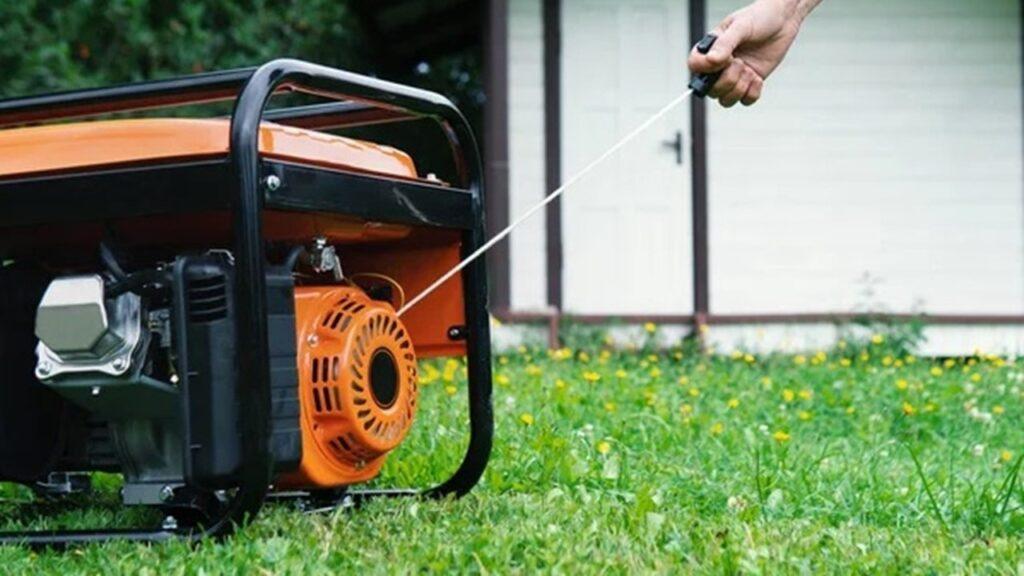
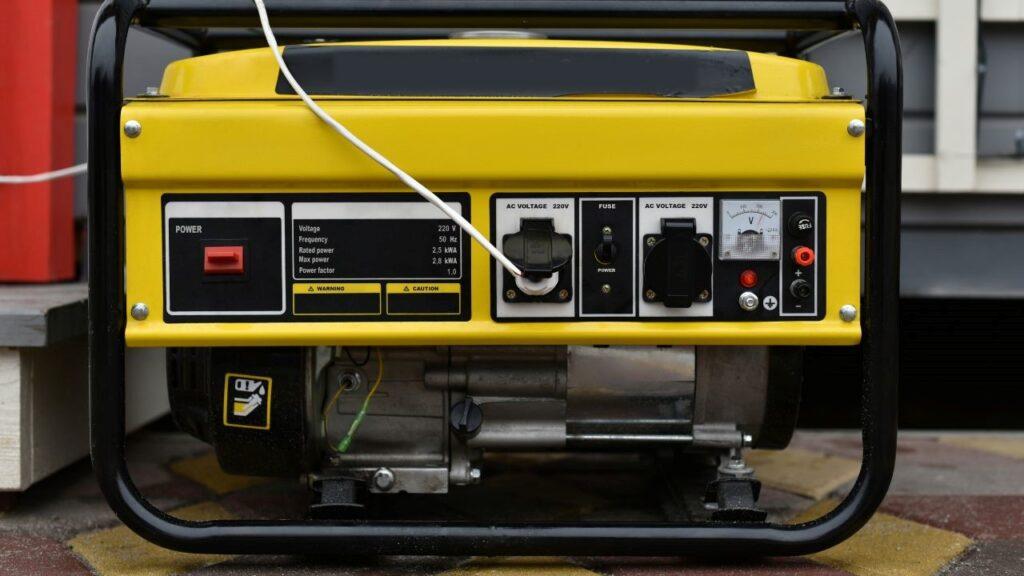
![The 7 Best 5000 Watt Generators Review 2025 – [Powerful & Quiet]](https://www.powerelectrichub.com/wp-content/uploads/2024/09/Best-5000-Watt-Generators-1024x576.jpg)
